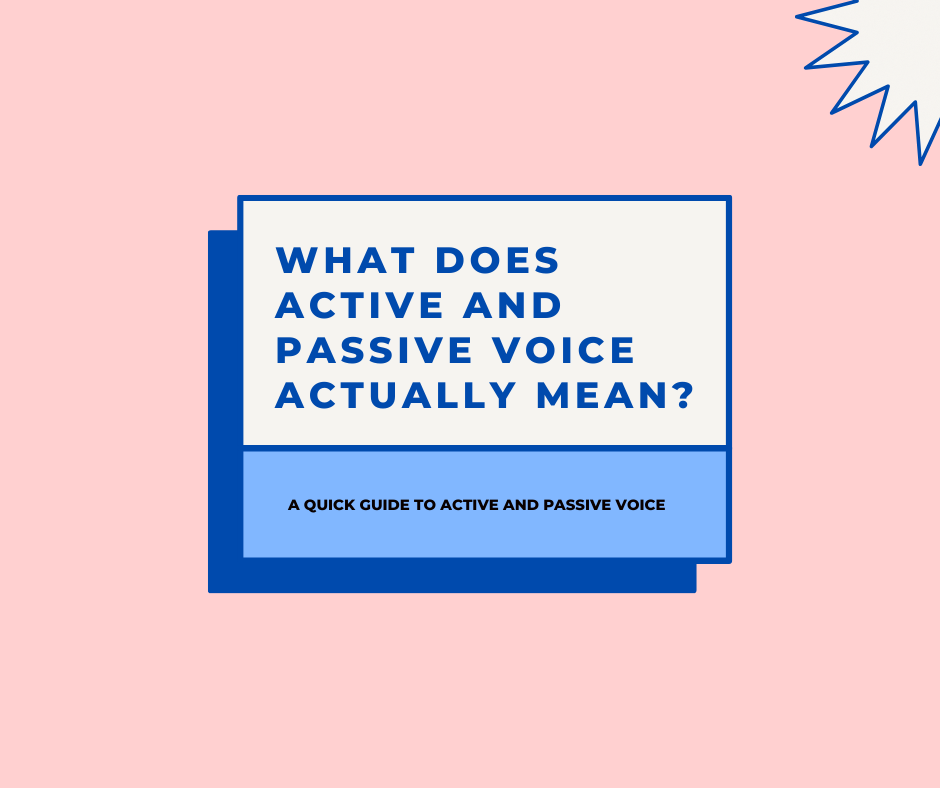A Quick Guide to Active Vs Passive Voice in Fiction Writing
When it comes to fiction writing, one of the subtler choices that can shape the flow of your story is whether to use active or passive voice.
If that sentence just made you scrunch your eyebrows together because you've heard the phrase but can't actually think of what it means (or, hey, perhaps you've never heard either term at all!) then you're definitely not alone. This blog post is here to break it down for you.

What's the big deal about active and passive voice?
In fiction, the choice between active and passive voice can affect how a scene feels to the reader. It can create urgency, focus or even a sense of mystery. But, before we jump into which to use and when, let's quickly cover what active and passive voice actually are. To do this, we kind of have to go back to early understandings of word classifications and sentence structure.
Active Voice: The subject of the sentence performs the action.
Example: The dog chased the cat.
Here, the dog (subject) is doing the action (chased) to the cat. It's direct, clear, and feels immediate.
Passive Voice: The action is performed on or to the subject.
Example: The cat was chased by the dog.
Now, the focus shifts to the cat, who is having the action 'done' to it. Notice how this version feels a little more distant, like you're watching from a step back.
Why writers tend to love active voice
In fiction, the active voice is often the go-to because it makes scenes feel dynamic and engaging. It keeps the reader’s attention on the character doing the action, which is usually what we want.
Think about it:
The knight slayed the dragon.
This sentence feels powerful. It thrusts the reader directly into the action. You can imagine the swing of the sword, the roar of the beast and the bravery of the knight.
Now let’s flip it into passive voice:
The dragon was slayed by the knight.
While it's technically correct, this version feels less vivid. The focus is shifted to the poor dragon (and not in an empathetic way), and the sentence has lost some of its punch.
That’s why active voice is often favoured in scenes where action or character agency is important. You want your reader to feel like they’re right in the middle of the battle, the chase or the escape!
Can you still use passive voice?
Passive voice can still be used as a secret weapon, however, particularly in fiction writing.
Passive voice isn’t the enemy of good fiction. In fact, it has its own place, and when used deliberately, it can add a lot to your writing.
One of the biggest advantages of the passive voice is that it can create a sense of mystery or emphasise the result of an action rather than who is performing it. This is especially handy when you want to hide who's responsible or draw attention away from the subject.
Let’s look at an example:
The jewels were stolen during the night.
This passive construction makes the fact that the jewels are gone the central focus, which could be more important in a scene where the "who" or "how" isn't yet known. This can build suspense for the reader.
Similarly, passive voice can be useful when the doer (the character performing the action) isn't important to the scene or plot or if you don't want to place blame:
Mistakes were made.
A very passive way to avoid saying who messed up, right?
Finding balance
So, which one should you use? The truth is that most fiction benefits from a healthy balance of both active and passive voice.
In general:
Use active voice when you want to make the scene feel direct, fast-paced and immersive. Active voice shines in action scenes, dialogue and moments where your character is in control or taking bold steps.
Use passive voice when you want to shift the focus away from the doer or when the action itself is more important than who did it. Passive voice works well for building tension, keeping secrets or conveying a lack of control.
Ultimately, the choice between active and passive voice isn't about one being "right" or "wrong"—it’s about how you want your story to feel. Active voice tends to be more direct and engaging, pulling readers into the action, while passive voice can add layers of subtlety, suspense or mystery.
If you’re unsure, perhaps try reading your sentences out loud. Do they feel punchy and energetic? That’s probably active voice. Do they sound like something is being done to someone or something? That’s passive.
Mastering when to use each will help you create the kind of vivid, engaging fiction that readers won’t be able to put down. So go ahead—experiment with both and see what brings your story to life!


0 Comments Add a Comment?